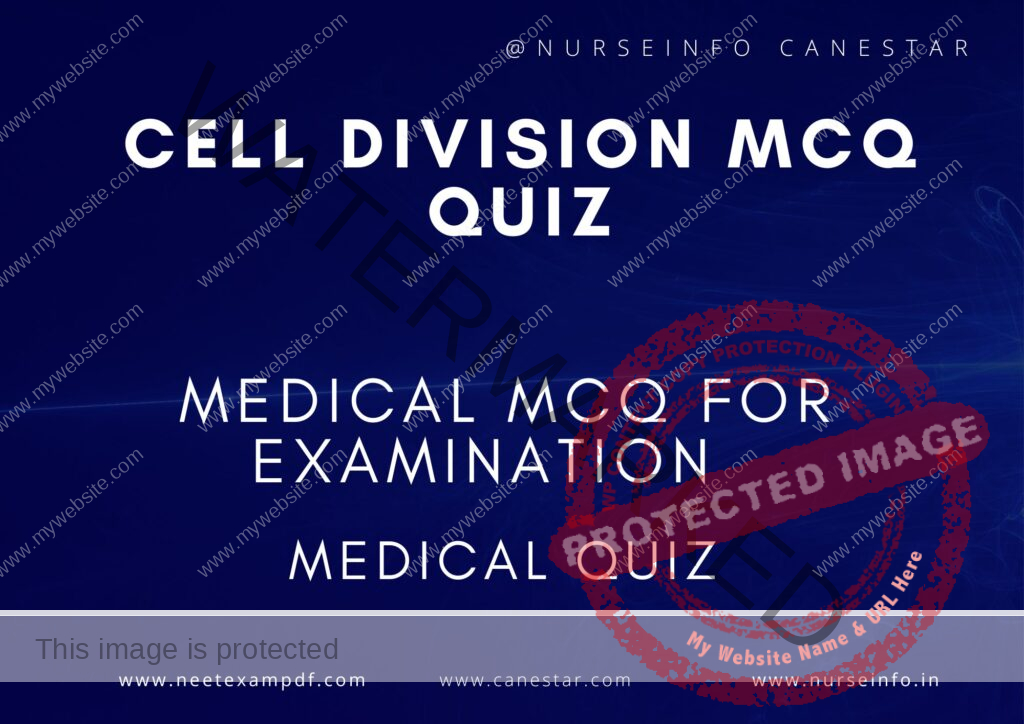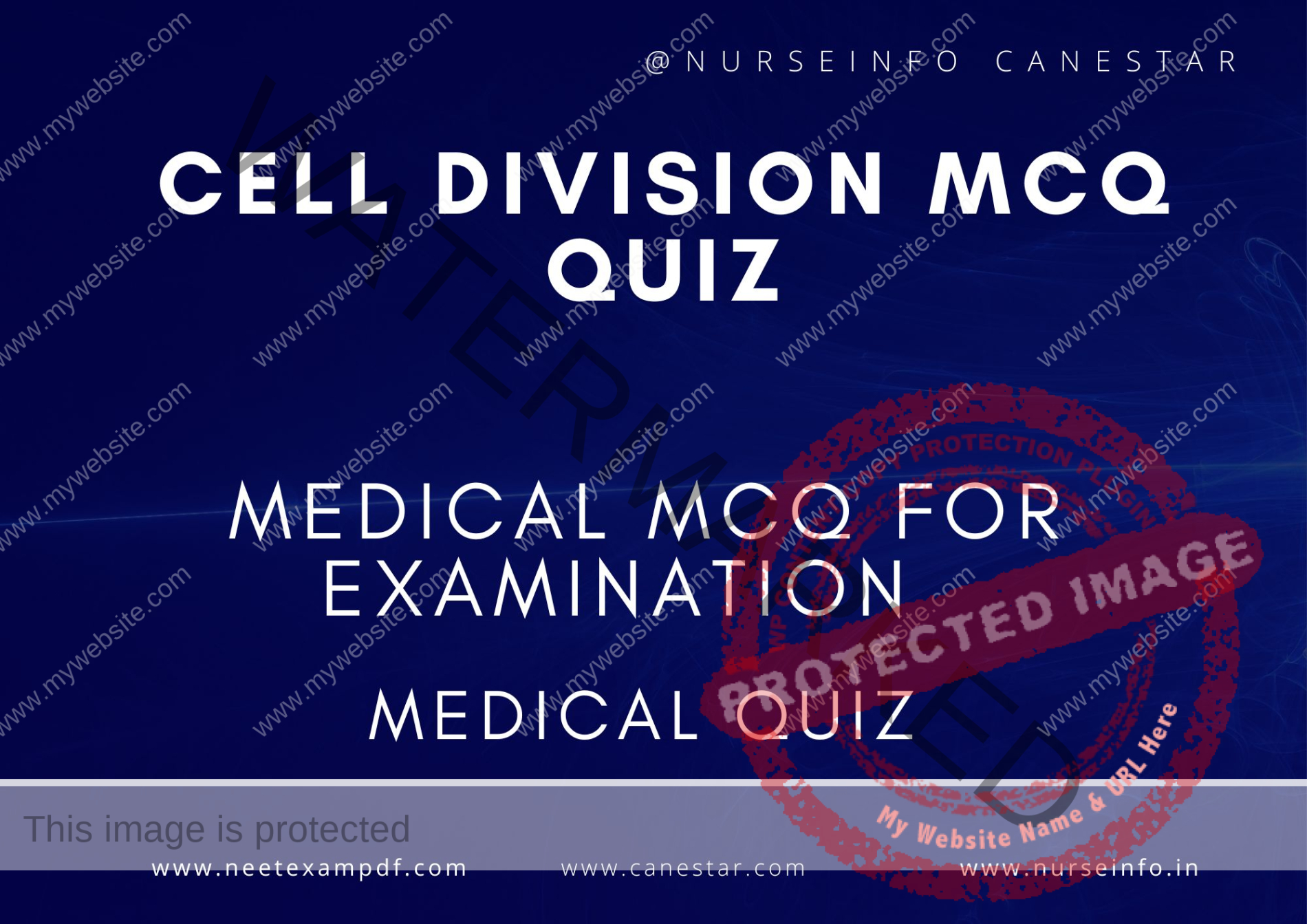MULTIPLE CHOICE QUESTIONS ON CELL DIVISION PRACTICE QUIZ – MCQS WITH RATIONALE ANSWER – CELL DIVISION MCQ QUESTIONS WITH RATIONALE
MCQ FOR CELL DIVISION QUIZ
These mcqs are prepared exclusively for medical professionals for exam preparation. MCQ is helpful to remember the concept on cell division mcq quiz. This multiple choice questions are helpful for preparation for DHA, PROMETRIC, MOH, HAAD, NCLEX, Medical, NEET and Nursing EXAMINATION
CELL DIVISION MCQ QUIZ
1. What is the primary purpose of mitosis in multicellular organisms?
A. Sexual reproduction
B. Genetic variation
C. Growth and repair
D. Meiosis
Answer: C. Growth and repair
Rationale: Mitosis results in two identical daughter cells, which helps in growth and the repair of damaged tissues.
2. During which phase of the cell cycle does DNA replication occur?
A. G1 phase
B. S phase
C. G2 phase
D. M phase
Answer: B. S phase
Rationale: DNA replication occurs during the S (synthesis) phase of the cell cycle, ensuring that each daughter cell has an identical set of chromosomes.
3. What structure is responsible for separating the chromosomes during mitosis?
A. Golgi apparatus
B. Spindle fibers
C. Endoplasmic reticulum
D. Ribosomes
Answer: B. Spindle fibers
Rationale: Spindle fibers, formed from microtubules, attach to chromosomes and help separate them during mitosis.
4. Which phase of mitosis is characterized by the alignment of chromosomes at the cell’s equator?
A. Prophase
B. Metaphase
C. Anaphase
D. Telophase
Answer: B. Metaphase
Rationale: During metaphase, chromosomes line up at the metaphase plate (cell’s equator), preparing for separation.
5. What happens during anaphase of mitosis?
A. Chromosomes condense
B. Chromosomes align at the equator
C. Sister chromatids separate
D. Nuclear envelope re-forms
Answer: C. Sister chromatids separate
Rationale: In anaphase, sister chromatids are pulled apart toward opposite poles of the cell by spindle fibers.
6. Which type of cell division results in four genetically diverse daughter cells?
A. Mitosis
B. Binary fission
C. Meiosis
D. Cytokinesis
Answer: C. Meiosis
Rationale: Meiosis produces four genetically diverse haploid cells (gametes) through two rounds of division.
7. Crossing over, which increases genetic diversity, occurs during which phase of meiosis?
A. Prophase I
B. Metaphase I
C. Anaphase I
D. Telophase I
Answer: A. Prophase I
Rationale: Crossing over occurs during prophase I of meiosis, where homologous chromosomes exchange genetic material.
8. What is the result of nondisjunction during meiosis?
A. Normal chromosome number
B. Two identical cells
C. Cells with abnormal chromosome numbers
D. Increased genetic diversity
Answer: C. Cells with abnormal chromosome numbers
Rationale: Nondisjunction is the failure of chromosomes to separate properly, resulting in gametes with abnormal chromosome numbers.
9. Which phase follows the G2 phase in the cell cycle?
A. S phase
B. G1 phase
C. M phase
D. Cytokinesis
Answer: C. M phase
Rationale: The M phase (mitosis) follows the G2 phase, where cell division occurs.
10. During which phase of mitosis do the nuclear envelope and nucleolus reappear?
A. Prophase
B. Metaphase
C. Anaphase
D. Telophase
Answer: D. Telophase
Rationale: During telophase, the nuclear envelope and nucleolus reappear around the separated chromosomes, which begin to decondense.
11. Cytokinesis is the process of:
A. Dividing the cell nucleus
B. Condensing chromosomes
C. Dividing the cytoplasm
D. Forming spindle fibers
Answer: C. Dividing the cytoplasm
Rationale: Cytokinesis is the division of the cytoplasm, resulting in two separate daughter cells.
12. In what type of cells does mitosis occur?
A. Gametes
B. Somatic cells
C. Bacteria
D. Viruses
Answer: B. Somatic cells
Rationale: Mitosis occurs in somatic (body) cells, resulting in two identical daughter cells.
13. Which structure is critical for chromosome movement during mitosis and meiosis?
A. Centrosome
B. Nucleolus
C. Mitochondrion
D. Chloroplast
Answer: A. Centrosome
Rationale: The centrosome organizes the microtubules and spindle fibers necessary for chromosome movement.
14. How many daughter cells are produced at the end of meiosis II?
A. One
B. Two
C. Three
D. Four
Answer: D. Four
Rationale: Meiosis II results in four haploid daughter cells from the two cells produced in meiosis I.
15. Which checkpoint ensures that all chromosomes are properly attached to the spindle apparatus before anaphase?
A. G1 checkpoint
B. G2 checkpoint
C. Metaphase checkpoint
D. S checkpoint
Answer: C. Metaphase checkpoint
Rationale: The metaphase checkpoint ensures that all chromosomes are properly attached to the spindle fibers before proceeding to anaphase.
16. What is the term for programmed cell death, a normal part of development and maintenance in multicellular organisms?
A. Apoptosis
B. Necrosis
C. Autophagy
D. Senescence
Answer: A. Apoptosis
Rationale: Apoptosis is a form of programmed cell death that is essential for development and maintaining healthy tissues.
17. Which phase of the cell cycle is the longest, accounting for about 90% of the total cycle time?
A. G1 phase
B. S phase
C. G2 phase
D. M phase
Answer: A. G1 phase
Rationale: The G1 phase, where the cell grows and performs its normal functions, is typically the longest phase of the cell cycle.
18. Which event is unique to meiosis and does not occur in mitosis?
A. Spindle fiber formation
B. Cytokinesis
C. Homologous chromosome pairing
D. Chromosome condensation
Answer: C. Homologous chromosome pairing
Rationale: Homologous chromosomes pair and undergo crossing over in meiosis, an event that does not occur in mitosis.
19. Which structure forms at the site of cytokinesis in plant cells?
A. Cell plate
B. Cleavage furrow
C. Centrosome
D. Spindle fiber
Answer: A. Cell plate
Rationale: In plant cells, a cell plate forms during cytokinesis, leading to the separation of the two daughter cells.
20. The G2 phase of the cell cycle is primarily associated with:
A. DNA replication
B. Cell growth and preparation for mitosis
C. Chromosome segregation
D. Cytokinesis
Answer: B. Cell growth and preparation for mitosis
Rationale: During the G2 phase, the cell continues to grow and prepares for the upcoming mitotic division.


